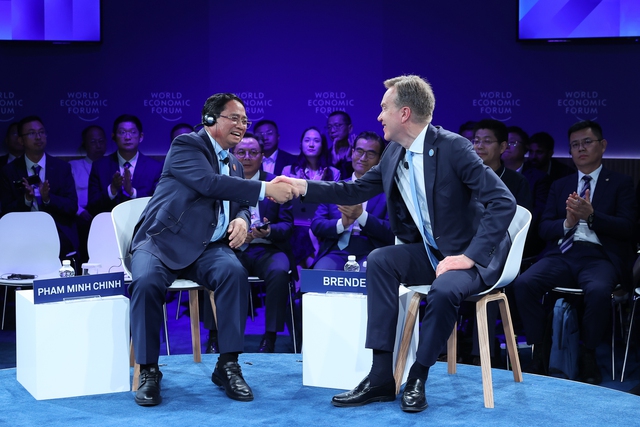Prime Minister shares Viet Nam's development path at WEF Tianjin Meeting
VGP - Prime Minister Pham Minh Chinh engaged in a policy dialogue themed "Viet Nam's New Era: From Vision to Action" with President and CEO of the World Economic Forum (WEF) Borge Brende on June 25. The event was a highlight of the World Economic Forum's 16th Annual Meeting of the New Champions in Tianjin, China.

Prime Minister Pham Minh Chinh (left) and President and CEO of the World Economic Forum (WEF) Borge Brende at the policy dialogue themed "Viet Nam's New Era: From Vision to Action" in Tianjin, China, June 25, 2025. Photo: VGP
Prime Minister Pham and President Brende discussed Viet Nam's new development vision and its experience in building an independent, self-reliant and globally-integrated economy, and navigating global instability through proactive diplomacy. Brende, clearly impressed, called Viet Nam a standout success story for its resilience and relentless growth amid global volatility.
When pressed on what's fueling Viet Nam's momentum, Prime Minister Pham outlined the country's vision to become a high-income developed country by 2045, a goal underpinned by an ambitious target of 8 percent GDP growth in 2025, with double-digit growth projected thereafter.
Viet Nam has every basis of achieve this goal, he said, pointing to a development path grounded in Marxism-Leninism and President Ho Chi Minh's ideology, and a rich cultural heritage, all backed by a political system led by the Communist Party of Viet Nam and a state "of the people, by the people, for the people".
Such has propelled Viet Nam to the third largest economy in Southeast Asia, nearing upper-middle-income status. With 17 Free Trade Agreements (FTAs) spanning 60 economies and a spot among the world's top 20 trading economies, Viet Nam's high level of economic openness and crisis-hardened savvy position it well for continued growth, he said.
The dialogue also spotlighted Viet Nam's foreign policy, which Brende praised for balancing ties with major powers like China and the U.S., its two largest trade partners, accounting for half of its total trade. Pham reaffirmed Viet Nam's foreign policy of independence, self-reliance, multilateralism, and diversification that positions the country as a trusted partner and a responsible member of the global community. On economic front, he said, Viet Nam is diversifying markets, products, and supply chains to remain agile amid global shifts.
On the building of a socialist-oriented market economy, the Government leader reiterated Viet Nam's determination to build an independent, self-reliant economy. "Internal resources remain the fundamental, strategic, long-term driver of growth, while external resources play a breakthrough role," he noted.
Addressing global challenges, he urged unity and adaptability, framing crises as opportunities for nations with the right mindset and strategies.
The session wrapped up with a lively Q&A, where the Government leader fielded questions from international scholars and delegates, expounding on Viet Nam's recent reforms. He detailed overhauls in mechanisms, infrastructure, and human capital, alongside streamlined administrative procedures, decentralised governance, and a restructured political system with a two-tier local governance model./.

